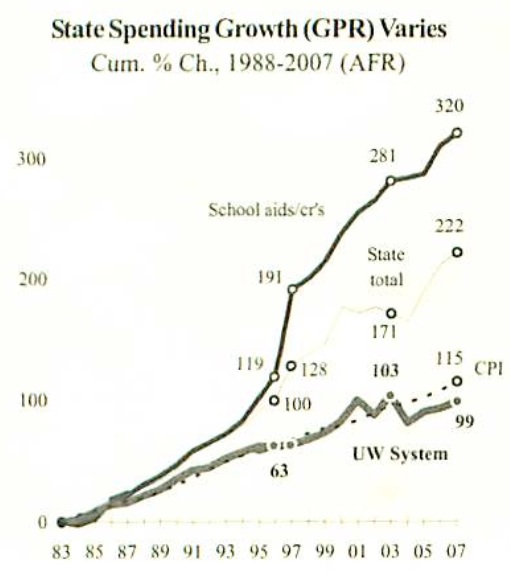Lawmakers also want to expand school voucher programs beyond the borders of Milwaukee and eastern Racine County. The programs allow parents who meet income thresholds to send their children to religious schools and other private schools at taxpayer expense.
Under the motion approved 12-4 along party lines by Republicans on the budget panel:
- Public schools would receive $150 more per student in general aid this fall and another $150 increase the following year. The plan would cost $289 million over two years, with $231.5 million funded with state taxes and the rest with an additional $52 million in higher local property taxes and an increase in expected revenues from the state lottery.
School districts would have the authority to spend this new money. Walker wanted to give schools $129 million in state aid but require all of it to go toward property tax relief, rather than be used for new expenses.
Under the budget committee’s proposal, total property taxes would increase by less than 1% per year, with school levies going up somewhat more than that.- A new voucher program would become available to all students outside Milwaukee and Racine. It would be limited to 500 students the first year and 1,000 students every year thereafter. Walker wanted no limits on the number of students in the program after the second year.
If there are more students seeking slots in the program than allowed, the proposal would allocate the available slots by lottery. The slots would go to the 25 schools with the most applications, with each school getting at least 10 seats.- The new program would be available to students in any school district. Walker wanted to make it available in districts with 4,000 or more students that were identified as struggling on school report cards issued by the state.
- No more than 1% of the students of any given school district could participate in the new program.
- Over 12 years, the negative financial impacts for the Milwaukee Public Schools from the voucher program here would be phased out.
- The new program would be available to students of families making 185% of the federal poverty level or less — well below the income thresholds for Milwaukee and Racine. Those programs are available to families making up to 300% of the federal poverty level, with a higher threshold for married couples.
- Voucher schools in all parts of the state would receive $7,210 per K-8 student and $7,856 per high school student — up from $6,442 currently. Walker wanted to provide $7,050 for students in kindergarten through eighth grade and the same larger increase to high school students.
Secret voucher ‘deal’ boosts their $ by 9% at the expense of WI’s 870,000 public school kids. owl.li/lHhx2 #WIedu
— Tony Evers (@WISuptTonyEvers) June 5, 2013
Wisconsin DPI Superintendent Tony Evers (PDF):
Today, Republican leaders are finalizing a deal to likely expand Wisconsin’s private school voucher program statewide. While this dramatic proposal has significant implications for citizens and taxpayers across Wisconsin, it has been developed behind closed doors with no public input, no public hearings, and no public fiscal analysis. If this proposal becomes law, taxpayers across Wisconsin will be financing a new entitlement for private school children whose tuition is currently paid for by their parents. To address the lack of information about the potential fiscal effects of this program, the attached table estimates potential long-term costs of statewide subsidization of private school tuition on a district-by-district basis. Cost to subsidize current private school students only: up to $560 million annually
While some lawmakers claim the purpose of the program is to provide educational choices to those who cannot afford it, the current school choice programs in Milwaukee and Racine provide vouchers to families who are already choosing to send their children to private schools. As many as 50% of the children participating in the Racine choice program were already in private schools when they began receiving a state-funded subsidy in
2011-12. If the voucher program is expanded statewide, it can be assumed that current private school families would also be eligible for this new entitlement.
Related:
- Wisconsin State Tax Based K-12 Spending Growth Far Exceeds University Funding

- “Schools should not rely on only WKCE data to gauge progress of individual students or to determine effectiveness of programs or curriculum”
- Are MMSD Programs Effective? Who Knows.
- Tony Evers notes and links.
- Vouchers notes and links.
